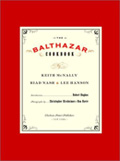Books |
The Balthazar Cookbook, by Keith McNally
Riad Nasr & Lee Hanson
By
Published: Jan 01, 2005
Category:
Food and Wine
Keith McNally started with a location — a coveted space at 80 Spring Street, in that trendy part of downtown New York known as SoHo — and a dog-eared photo of a brasserie bar in France. Not a famous place. Not even a brasserie noted for anything. He just liked the look.
Balthazar opened in the Spring of 1997. McNally had never opened a restaurant that failed, but he had never had a success like this. An unlisted phone only made the frenzy more intense. Anyone who was anybody needed to be seen at this stage set — a 180-seat French brasserie, faithfully reproduced in New York. Faded mirrors. Burnished wood. Brass rails. White tablecloths. Waiters in white shirts and black ties.
It took a while for us to get a reservation. By then, Balthazar was a restaurant, not a scene. And, finally, the place could be appreciated for its virtues: honest food, cooked with as much care as haut cuisine.
The French Fries, for example. When you get them, they’re long and upright, served the European way: in a paper cone, with a dollop of mayonnaise on the side. And these are, mind you, hand-cut, soaked in water overnight, fried first at a low temperature to cook the spuds, then again at a higher temperature to crisp and caramalize the edges of the fries. Bathazar serves 750 pounds of French Fries cooked this way every day, "the largest production of hand-cut fries in any serious restaurant in America" — imagine the prep work in that kitchen.
Do not open the Balthazar cookbook if you are hungry and hours away from a kitchen. The pictures are devastatingly gorgeous — you’ll want to cook and eat everything right away. And as you look at the recipes, you’ll see that you can. This is not complicated; the recipes are streamlined for home cooking.
Try the roast chicken recipe. It solves the problem that has troubled me all the decades I have cooked chickens — namely, how do you brown the thing all over. Turns out there’s a simple solution. So simple I would never have thought of it.
The recipe that you will drive you crazy — if you’re not Against Beef, that is — is Braised Short Ribs. In the photograph, they’re cooked so long that a knife is unnecessary. Yes, the recipe calls for Veal Stock, which, the authors note, is only for the "hard core." But a substitute works well (and I’ve used it here). And the preparation of the other ingredients isn’t odious. Best of all, this is one of those meals that tastes better the day after it’s made. It is, thus, a dream entree for a dinner party.
BRAISED SHORT RIBS
serves 8
6 beef short ribs ( 5 to 7 pounds)
2 sprigs of rosemary
6 sprigs of thyme
1 bay leaf
1 celery stalk, halved
3 TBS kosher salt
2 TBS coarsely ground black pepper
3 TBS vegetable oil
3 medium carrots, peeled and cut into one-inch pieces
1 medium onion, roughly chopped
4 shallots, peeled and sliced 1/4 inch thick
5 garlic cloves, peeled and halved
3 TBS tomato paste
3 TBS all-purpose flour
1/2 cup ruby port
4 cups full-bodied red wine
5 cups beef stock (not from cubes)
Preheat the oven to 325.
Bind each rib with cotton kitchen twine. Place the rosemary, thyme and bay leaf between the two celery halves and bind with kitchen twine.
Season the ribs with 2 teaspoons of salt and pepper. Heat the oil in a large Dutch oven over a hot flame until it smokes. In two batches, brown the short ribs well on both sides, about three minutes per side. Remove the ribs and drain almost all of the oil when done.
Lower the flame to medium, and add the carrots, onions, shallots and garlic to the pot. Saute for 5 minutes, until the onion is soft and light brown. Stir in the tomato paste and cook for two minutes. Add the flour and stir well. Add the port, red wine and the celery/herb bundle. Raise the flame to high and cook 20 minutes, until the liquid is reduced by a third.
Return the ribs to the pot (they’ll stack in two layers). Add the stock and the remaining salt. If the stock doesn’t cover the ribs by an inch, add water until it does. Bring to a gentle simmer, cover and cook for 3 hours, stirring occasionally. When the meat starts to fall of the bone, it’s done.
Transfer the ribs to a large platter and remove the strings. Skim the fat from the surface of the sauce. Strain sauce through a sieve into a medium saucepan. Discard the solids. Over medium heat, reduce the liquid for about an hour until less than half — about 4 cups — remains.
Return the ribs to the pot, simmer for 10 minutes to reheat. Serve with garlic mashed potatoes and roasted vegetables.
To buy "The Balthazar Cookbook" from Amazon.com, click here.


